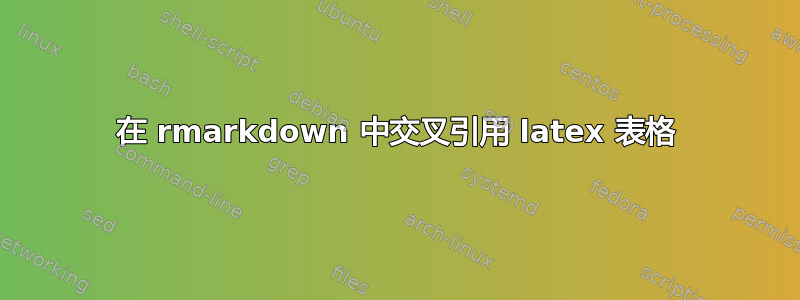
我尝试在 RMarkdown 中交叉引用 latex 表。生成了超链接(单击 ?? 可转到表格),但未显示表格编号,而是显示 ??。我尝试了带有和不带有 latex 块的版本。我使用 pandoc 版本 >2.0,以便原料乳胶可以使用。
如何在 RMarkdown 中交叉引用原始乳胶表?
---
header-includes:
- \usepackage{amsmath, dcolumn, xcolor, hyperref, svg, url, makecell, array, fourier, tabularx, booktabs, caption, float , resizegather, verbatim,threeparttable, caption, pifont, soul }
- \newcommand{\comm}[1]{\ignorespaces}
output:
bookdown::pdf_document2:
keep_tex: yes
template: template.tex
fig_caption: true
citation_package: biblatex
number_sections: true
toc: true
lot: true
lof: true
graphics: true
biblio-title: References
fontsize: 12pt
geometry: lmargin = 3 cm,rmargin = 2.5cm,tmargin=2.5cm,bmargin=2.5cm
biblio-files: references.bib
classoption: a4paper
---
The gradient boosting method implementations of GBM,XGBoost,LightGBM and CatBoost used in this paper features different hyperparameter to tune as shown in table \@ref(tab:hyperparameter).
\begin{table}[!htbp]
\captionsetup{labelsep=newline, justification=centering}
\begin{threeparttable}
\caption{\textit{Hyperparemeter tuned for each method}}
\begin{tabular*}{ \linewidth}{{l@{\extracolsep{\fill}}cr}}
\toprule
\multicolumn{1}{l}{\textbf{ Parameter}}& \multicolumn{1}{c}{Model} & \multicolumn{1}{c}{Range} \\
\midrule
\addlinespace
\textbf{tree depth} & All & [1,100]\\
\addlinespace
\textbf{mtry (see table notes)} & All & [0,27]\\
\addlinespace
\textbf{learning rate} & GBM, XGBoost, LightGBM, Catboost & [0,1]\\
\addlinespace
\textbf{loss reduction} & GBM, XGBoost, LightGBM & [0,$\infty$]\\
\addlinespace
\textbf{tree depth} & GBM, XGBoost ,LightGBM, Catboost & [1,$\infty$]\\
\addlinespace
\textbf{minimal node size} & GBM, XGBoost, LightGBM, Catboost & [1,$\infty$]\\
\bottomrule
\bottomrule
\end{tabular*}
\begin{tablenotes}[flushleft]
\small
\item \textit{Note: The upper bound of the hyperparameter \textit{mtry} differs due to the chosen model. This is 27 for all models despite catboost which uses ordered target statistics to encode \textit{factor} variables. The latter, as explained in the section X, do not expand the dataset but encode the variable itself. Therefore the upper bound of the hyperparameter \textit{mtry} is 22 instead of 27.}
\end{tablenotes}
\end{threeparttable}
\label{tab:hyperparameter}
\end{table}
The gradient boosting method implementations of GBM,XGBoost,LightGBM and CatBoost used in this paper features different hyperparameter to tune as shown in table \@ref(tab:hyperparameter_chunk).
```{=latex}
\begin{table}[!htbp]
\captionsetup{labelsep=newline, justification=centering}
\begin{threeparttable}
\caption{\textit{Hyperparemeter tuned for each method}}
\begin{tabular*}{ \linewidth}{{l@{\extracolsep{\fill}}cr}}
\toprule
\multicolumn{1}{l}{\textbf{ Parameter}}& \multicolumn{1}{c}{Model} & \multicolumn{1}{c}{Range} \\
\midrule
\addlinespace
\textbf{tree depth} & All & [1,100]\\
\addlinespace
\textbf{mtry (see table notes)} & All & [0,27]\\
\addlinespace
\textbf{learning rate} & GBM, XGBoost, LightGBM, Catboost & [0,1]\\
\addlinespace
\textbf{loss reduction} & GBM, XGBoost, LightGBM & [0,$\infty$]\\
\addlinespace
\textbf{tree depth} & GBM, XGBoost ,LightGBM, Catboost & [1,$\infty$]\\
\addlinespace
\textbf{minimal node size} & GBM, XGBoost, LightGBM, Catboost & [1,$\infty$]\\
\bottomrule
\bottomrule
\end{tabular*}
\begin{tablenotes}[flushleft]
\small
\item \textit{Note: The upper bound of the hyperparameter \textit{mtry} differs due to the chosen model. This is 27 for all models despite catboost which uses ordered target statistics to encode \textit{factor} variables. The latter, as explained in the section X, do not expand the dataset but encode the variable itself. Therefore the upper bound of the hyperparameter \textit{mtry} is 22 instead of 27.}
\end{tablenotes}
\end{threeparttable}
\label{tab:hyperparameter_chunk}
\end{table}
```


